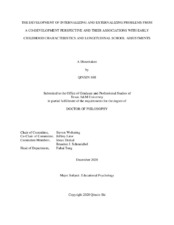| dc.description.abstract | As internalizing and externalizing problems often co-occur, this dissertation utilized a longitudinal dataset of 784 at-risk children (predominantly from low-income families and academically at-risk; 52.6% male) followed yearly from grade 1 to grade 12 to: (a) explore the heterogeneity in the co-development patterns of internalizing and externalizing problems by using both variable and person-centered approach, and (b) investigate early childhood antecedents that might explain differentiated co-developmental patterns, and (c) explore the patterns of co-occurring problems and their long-term associations with teacher-child relationship quality and academic (math and reading) performance were assessed.
In study 1, a bi-factor model, consisting of a general psychopathology factor and two specific factors of domain-specific internalizing and externalizing factor, fitted best across four developmental periods (early childhood, late childhood, early adolescence, late adolescence) and across parent and teacher report. The evidence from this variable-centered approach indicated that co-occurrence is the rule, other than exception. From person-centered approach, results revealed four distinct co-development trajectories of internalizing and externalizing problems including chronic co-occurring, moderate co-occurring, pure-externalizing, and low-risk groups.
In study 2, the antecedents consisted of individual (i.e., ego-resilient personality, intelligence, language ability, gender, and ethnicity) and contextual factors (i.e., maternal support and responsiveness, family socioeconomic adversity, teacher-child relationship conflict, and peer rejection). While children who belonged to any of the three higher risk groups (identified from study 1) exhibited more adverse early childhood antecedents compared with the low-risk group, the chronic co-occurring group displayed the most severe profiles of early childhood antecedents compared to the moderate co-occurring and the pure-externalizing groups. Common antecedents for the three higher risk groups were lower ego-resilient personality, higher teacher-child relationship conflict, being male and being African-American. Low language ability and peer rejection were identified as unique antecedents for the chronic co-occurring group.
In study 3, children with chronic co-occurring internalizing and externalizing problems exhibited more sustained teacher-child conflict, lower teacher-child warmth, and lower math and reading performance. Children with pure externalizing and moderate co-occurring problems were also at risk for scholastic difficulties, but to a lesser magnitude than children with chronic co-occurring problems. Compared to children in the low risk group, those in all three risk groups exhibited patterns of scholastic maladjustment that were either sustained or worsened after the transition to middle school. | en |


